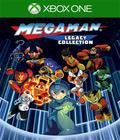Mega Man is easily one of Capcom's most popular characters, but he hasn't seen much in the way of a new release since Mega Man 10 five years ago. The Mega Man Legacy Collection attempts to fill the void by collecting the first six Mega Man games for the budget price of $15. It's more than a bare-bones collection, but at the same time, it doesn't offer the depth or breadth of other anthology collections.
Fire up the collection for the first time, and you are presented with games, challenges and a music player. Each of the six games offers a port of the original NES version along with database and museum options. The database highlights all of the different characters and reveals their stats, such as hit points and special weapon weaknesses. You can also practice boss robot fights by selecting them from the database. The museum features production art (some of which is duplicated from the database) as well as concept art.
Oddly, the museum doesn't offer any ability to go full screen with the art. The game's header and footer images are always present, blocking off the top and bottom parts of the screen. Given that the museum is supposed to show off the artwork, it seems counterintuitive to prevent players from displaying said artwork as a full-screen image.
The games can be displayed in three different resolutions. Original appears to be four times the original resolution. Full scales the image, so it uses the full height of your screen. Wide stretches the image to fill a full 16x9 screen but distorts the picture in the process. There is absolutely no reason why you'd want to use wide when playing one of the games. Empty space on either side of the image can be left black or filled with custom border artwork.
Displayed without a filter, the original pixel art is crisp and clear, looking good even on a large HDTV screen. There are two scan line filters available if you prefer the retro look. The monitor option drops the scan lines onto the screen, while the TV filter adds additional distortion, such as alias shimmering and mild ghosting.
The music player offers full soundtracks from each of the six games but also suffers from an odd limitation, just like the art in the museum. While you have the option to play any of the individual songs, there is no way to play a full soundtrack. You can't hit "play" and expect it to move on to the next track. There is no way to setup a playlist. All you can do is wait for a track to finish, manually move down and start the next one.
Jumping into the games, the gameplay seems authentic, with all of the bosses, levels and weapons as they were when originally released. This includes the original difficulty levels, as video games weren't incredibly long when Mega Man debuted. In order to make up for the relatively short length of the individual levels, the early Mega Man franchise relied on pixel-perfect accuracy. If you didn't have it, the games weren't shy about making you suffer for it.
This isn't a bad thing in and of itself, but when the games are as unforgiving as these are, the controls have to be exceptionally responsive, and that didn't always seem to be the case. Playing through the six games in the collection, I had the consistent feeling of input lag and occasional dropped inputs. As an example, there were instances when I would be facing left, press right and then fire. Instead of seeing the Blue Bomber turn and fire, he would just fire to the left. The input lag could be worked around by memorizing the upcoming sections, but dropped inputs were exceptionally frustrating when they did occur since they couldn't be predicted.
The last section of the collection features the challenges. These offer short timed segments for you to beat. Some are remixed portions of levels, others are boss rush sequences. The challenges are fun to play and are the highlight of the collection for Mega Man fans. If you didn't grow up with the series, you'll probably want to play through the games before jumping into the challenges; if you did, though, you'll want to start here. Don't expect anything too crazy (these aren't on the level of NES Remix mash-ups), but they will test your button-mashing prowess.
Going with ports rather than straight emulation of the original games was an interesting choice, but as an overall package, Mega Man Legacy Collection feels more like a basic collection of older games than a tribute to the franchise. The extras that are present are a nice touch, but they are hampered by poor organization and a less-than-ideal user experience. Jumping back into the Mega Man games is great for nostalgia, but playing them all back-to-back is a good reminder of how basic old game design actually was.
If you're a hardcore fan of the Blue Bomber and don't otherwise have access to the games, the Mega Man Legacy Collection is a convenient way to replay these Capcom classics, but as a collection, it doesn't compare to Rare Replay or even the last-gen SEGA Vintage Collection games that were put together by M2.
Score: 6.5/10
More articles about Mega Man Legacy Collection











 Mega Man Legacy Collection includes faithful reproductions of the original six Mega Man games along with a new Challenge Mode and a Museum collection of art assets that will appeal to both new players and diehard fans.
Mega Man Legacy Collection includes faithful reproductions of the original six Mega Man games along with a new Challenge Mode and a Museum collection of art assets that will appeal to both new players and diehard fans.

















